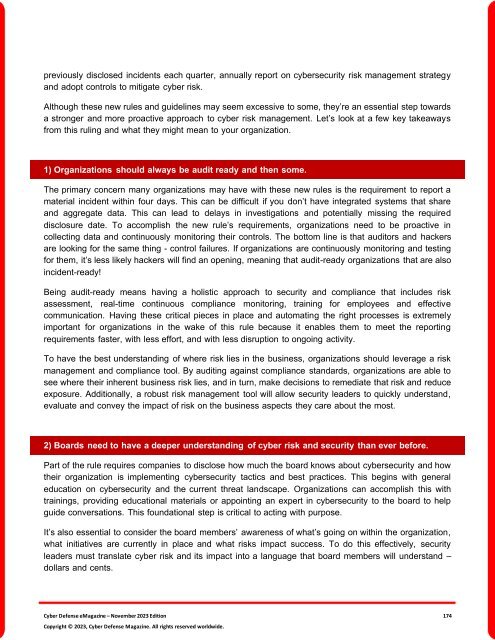The Cyber Defense eMagazine November Edition for 2023
Cyber Defense eMagazine November Edition for 2023 #CDM #CYBERDEFENSEMAG @CyberDefenseMag by @Miliefsky a world-renowned cyber security expert and the Publisher of Cyber Defense Magazine as part of the Cyber Defense Media Group as well as Yan Ross, Editor-in-Chief and many more writers, partners and supporters who make this an awesome publication! 196 page November Edition fully packed with some of our best content. Thank you all and to our readers! OSINT ROCKS! #CDM #CDMG #OSINT #CYBERSECURITY #INFOSEC #BEST #PRACTICES #TIPS #TECHNIQUES
Cyber Defense eMagazine November Edition for 2023 #CDM #CYBERDEFENSEMAG @CyberDefenseMag by @Miliefsky a world-renowned cyber security expert and the Publisher of Cyber Defense Magazine as part of the Cyber Defense Media Group as well as Yan Ross, Editor-in-Chief and many more writers, partners and supporters who make this an awesome publication! 196 page November Edition fully packed with some of our best content. Thank you all and to our readers! OSINT ROCKS! #CDM #CDMG #OSINT #CYBERSECURITY #INFOSEC #BEST #PRACTICES #TIPS #TECHNIQUES
Create successful ePaper yourself
Turn your PDF publications into a flip-book with our unique Google optimized e-Paper software.
previously disclosed incidents each quarter, annually report on cybersecurity risk management strategy<br />
and adopt controls to mitigate cyber risk.<br />
Although these new rules and guidelines may seem excessive to some, they’re an essential step towards<br />
a stronger and more proactive approach to cyber risk management. Let’s look at a few key takeaways<br />
from this ruling and what they might mean to your organization.<br />
1) Organizations should always be audit ready and then some.<br />
<strong>The</strong> primary concern many organizations may have with these new rules is the requirement to report a<br />
material incident within four days. This can be difficult if you don’t have integrated systems that share<br />
and aggregate data. This can lead to delays in investigations and potentially missing the required<br />
disclosure date. To accomplish the new rule’s requirements, organizations need to be proactive in<br />
collecting data and continuously monitoring their controls. <strong>The</strong> bottom line is that auditors and hackers<br />
are looking <strong>for</strong> the same thing - control failures. If organizations are continuously monitoring and testing<br />
<strong>for</strong> them, it’s less likely hackers will find an opening, meaning that audit-ready organizations that are also<br />
incident-ready!<br />
Being audit-ready means having a holistic approach to security and compliance that includes risk<br />
assessment, real-time continuous compliance monitoring, training <strong>for</strong> employees and effective<br />
communication. Having these critical pieces in place and automating the right processes is extremely<br />
important <strong>for</strong> organizations in the wake of this rule because it enables them to meet the reporting<br />
requirements faster, with less ef<strong>for</strong>t, and with less disruption to ongoing activity.<br />
To have the best understanding of where risk lies in the business, organizations should leverage a risk<br />
management and compliance tool. By auditing against compliance standards, organizations are able to<br />
see where their inherent business risk lies, and in turn, make decisions to remediate that risk and reduce<br />
exposure. Additionally, a robust risk management tool will allow security leaders to quickly understand,<br />
evaluate and convey the impact of risk on the business aspects they care about the most.<br />
2) Boards need to have a deeper understanding of cyber risk and security than ever be<strong>for</strong>e.<br />
Part of the rule requires companies to disclose how much the board knows about cybersecurity and how<br />
their organization is implementing cybersecurity tactics and best practices. This begins with general<br />
education on cybersecurity and the current threat landscape. Organizations can accomplish this with<br />
trainings, providing educational materials or appointing an expert in cybersecurity to the board to help<br />
guide conversations. This foundational step is critical to acting with purpose.<br />
It’s also essential to consider the board members’ awareness of what’s going on within the organization,<br />
what initiatives are currently in place and what risks impact success. To do this effectively, security<br />
leaders must translate cyber risk and its impact into a language that board members will understand –<br />
dollars and cents.<br />
<strong>Cyber</strong> <strong>Defense</strong> <strong>eMagazine</strong> – <strong>November</strong> <strong>2023</strong> <strong>Edition</strong> 174<br />
Copyright © <strong>2023</strong>, <strong>Cyber</strong> <strong>Defense</strong> Magazine. All rights reserved worldwide.

















